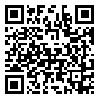Wed, Dec 3, 2025
Volume 33, Issue 4 (9-2023)
JHNM 2023, 33(4): 250-258 |
Back to browse issues page
Download citation:
BibTeX | RIS | EndNote | Medlars | ProCite | Reference Manager | RefWorks
Send citation to:



BibTeX | RIS | EndNote | Medlars | ProCite | Reference Manager | RefWorks
Send citation to:
Faraji Dehsorkhi H, Azizi Shamami M, Hayat A A, Rokni J. Predicting Training Transfer of Oxygen Therapy During COVID-19: Theory of Planned Behavior Application. JHNM 2023; 33 (4) :250-258
URL: http://hnmj.gums.ac.ir/article-1-2196-en.html
URL: http://hnmj.gums.ac.ir/article-1-2196-en.html
1- Assistant Professor, Department of Education, Faculty of Literature and Humanities, Shahid Bahonar University, Kerman, Iran.
2- Assistant Professor, Department of Education, Faculty of Humanities and Social Sciences, University of Mazandaran, Babolsar, Iran. ,mazizi@umz.ac.ir
3- Assistant Professor, Department of Medical Education, School of Medicine, Shiraz University of Medical Sciences, Shiraz, Iran.
4- General Psychology (PhD), Imam Hossein Hospital, Shahid Beheshti University, Tehran, Iran.
2- Assistant Professor, Department of Education, Faculty of Humanities and Social Sciences, University of Mazandaran, Babolsar, Iran. ,
3- Assistant Professor, Department of Medical Education, School of Medicine, Shiraz University of Medical Sciences, Shiraz, Iran.
4- General Psychology (PhD), Imam Hossein Hospital, Shahid Beheshti University, Tehran, Iran.
Abstract: (1354 Views)
Introduction: Patients with severe COVID-19 symptoms need respiratory support. Therefore, nurses should use oxygen therapy knowledge and skills to treat such patients. Despite heavy investment in health care training to improve nurses’ skills, such as oxygen therapy skills, only a small portion of training is transferred to the workplace.
Objective: The present study aims to predict training transfer (use of oxygen therapy in the workplace) among nurses using the theory of planned behavior (TPB).
Materials and Methods: This cross-sectional study was conducted on nurses who participated in the oxygen therapy workshop and was selected using the method proposed by a random sample of 127 nurses. The TPB questionnaire and the oxygen therapy checklist were used to collect data. To analyze the data, structural equation modeling was applied.
Results: The results showed that nurses’ attitudes toward oxygen therapy (β=0.358, 95%CI, 0.182%-0.542%, P=0.01), subjective norms regarding oxygen therapy (β=0.246 95%CI, 0.0.018%-0.223%, P=0.01), and perceived behavioral control over oxygen therapy (β=0.229, 95%CI, 0.050%-0.264%, P=0.01) are significant predictors of intention toward oxygen therapy application. Moreover, the results showed that perceived behavioral control over oxygen therapy (β=0.412, 95%CI, 0.226%-0.499%, P=0.01) and intention toward the use of oxygen therapy (β=0.360, 95%CI, 0.241%-0.640%, P=0.01) are significant predictors of nurses’ actual use of oxygen therapy.
Conclusion: The TPB can predict the intention to use oxygen therapy and the actual use of oxygen therapy in nursing staff. Therefore, this theory can guide health officials to create a suitable environment for using oxygen therapy.
Objective: The present study aims to predict training transfer (use of oxygen therapy in the workplace) among nurses using the theory of planned behavior (TPB).
Materials and Methods: This cross-sectional study was conducted on nurses who participated in the oxygen therapy workshop and was selected using the method proposed by a random sample of 127 nurses. The TPB questionnaire and the oxygen therapy checklist were used to collect data. To analyze the data, structural equation modeling was applied.
Results: The results showed that nurses’ attitudes toward oxygen therapy (β=0.358, 95%CI, 0.182%-0.542%, P=0.01), subjective norms regarding oxygen therapy (β=0.246 95%CI, 0.0.018%-0.223%, P=0.01), and perceived behavioral control over oxygen therapy (β=0.229, 95%CI, 0.050%-0.264%, P=0.01) are significant predictors of intention toward oxygen therapy application. Moreover, the results showed that perceived behavioral control over oxygen therapy (β=0.412, 95%CI, 0.226%-0.499%, P=0.01) and intention toward the use of oxygen therapy (β=0.360, 95%CI, 0.241%-0.640%, P=0.01) are significant predictors of nurses’ actual use of oxygen therapy.
Conclusion: The TPB can predict the intention to use oxygen therapy and the actual use of oxygen therapy in nursing staff. Therefore, this theory can guide health officials to create a suitable environment for using oxygen therapy.
Article Type : Research |
Subject:
Special
Received: 2023/07/3 | Accepted: 2023/06/29 | Published: 2023/06/29
Received: 2023/07/3 | Accepted: 2023/06/29 | Published: 2023/06/29
Send email to the article author
| Rights and permissions | |
 | This work is licensed under a Creative Commons Attribution-NonCommercial 4.0 International License. |






